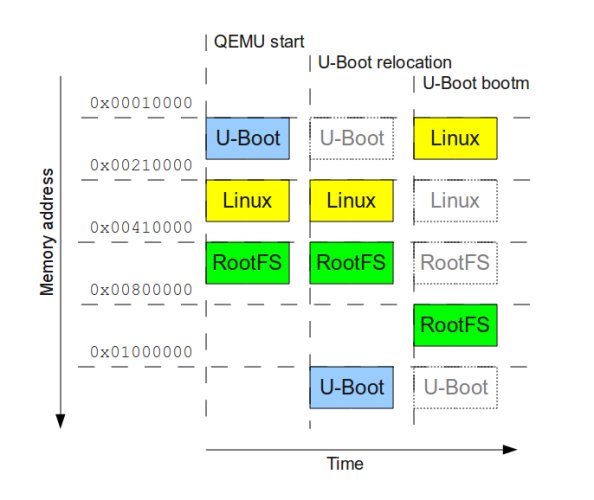Booting Linux with U-Boot on QEMU ARM
Posted on 2010/04/12
In recent months I played with QEMU emulation of an ARM Versatile Platform Board, making it run bare metal programs, the U-Boot boot-loader and a Linux kernel complete with a Busybox-based file system. I tried to put everything together to emulate a complete boot procedure, but it was not so simple. What follows is a description of what I’ve done to emulate a complete boot for an emulated ARM system, and the applied principles can be easily transferred to other different platforms.
Prerequisites
qemu-system-arm: can be installed on Ubuntu with “sudo apt-get install qemu-kvm-extras“, on Debian with “aptitude install qemu” as root.mkImage: can be installed with the packageuboot-mkimage. Alternatively, it is compiled from U-Boot source.arm-none-eabitoolchain: can be downloaded from the the CodeSourcery ARM EABI toolchain pagezImage: the Linux kernel created in my previous post hererootfs.img.gz: the Busybox-based file system created in my previous post here
The boot process
On real, physical boards the boot process usually involves a non-volatile memory (e.g. a Flash) containing a boot-loader and the operating system. On power on, the core loads and runs the boot-loader, that in turn loads and runs the operating system. QEMU has the possibility to emulate Flash memory on many platforms, but not on the VersatilePB. There are patches ad procedures availablethat can add flash support, but for now I wanted to leave QEMU as it is.
QEMU can load a Linux kernel using the -kernel and -initrd options; at a low level, these options have the effect of loading two binary files into the emulated memory: the kernel binary at address0x10000 (64KiB) and the ramdisk binary at address 0x800000 (8MiB). Then QEMU prepares the kernel arguments and jumps at 0x10000 (64KiB) to execute Linux. I wanted to recreate this same situation using U-Boot, and to keep the situation similar to a real one I wanted to create a single binary image containing the whole system, just like having a Flash on board. The -kernel option in QEMU will be used to load the Flash binary into the emulated memory, and this means the starting address of the binary image will be 0x10000 (64KiB).
Understanding memory usage during the boot process is important because there is the risk of overwriting something during memory copy and relocation. One feature of U-Boot is self-relocation, which means that on execution the code copies itself into another address, which by default is 0x1000000 (16MiB). This feature comes handy in our scenario because it frees lower memory space in order to copy the Linux kernel. The compressed kernel image size is about 1.5MiB, so the first 1.5MiB from the start address must be free and usable when U-Boot copies the kernel. The following figure shows the solution I came up with:
At the beginning we have three binary images together: U-Boot (about 80KiB), Linux kernel (about 1.5MiB) and the root file system ramdisk (about 1.1MiB). The images are placed at a distance of 2MiB, starting from address 0x10000. At run-time U-boot relocates itself to address 0x1000000, thus freeing 2MiB of memory from the start address. The U-Boot command bootm then copies the kernel image into 0x10000 and the root filesystem into 0x800000; after that then jumps at the beginning of the kernel, thus creating the same situation as when QEMU starts with the -kernel and-initrd options.
Building U-Boot
The problem with this solution is that U-Boot, when configured to be built for VersatilePB, does not support ramdisk usage, which means that it does not copy the ramdisk during the bootmcommand, and it does not give any information about the ramdisk to the kernel. In order to give it the functionality I need, I patched the original source code of U-Boot before compilation. The following code is the patch to apply to u-boot-2010.03 source tree:
